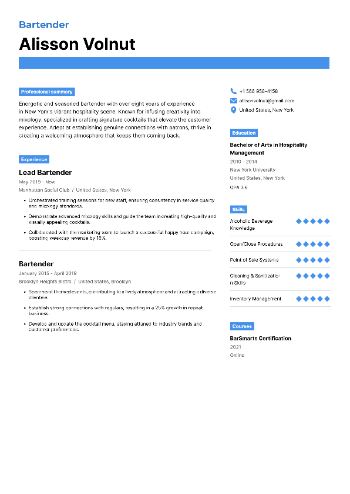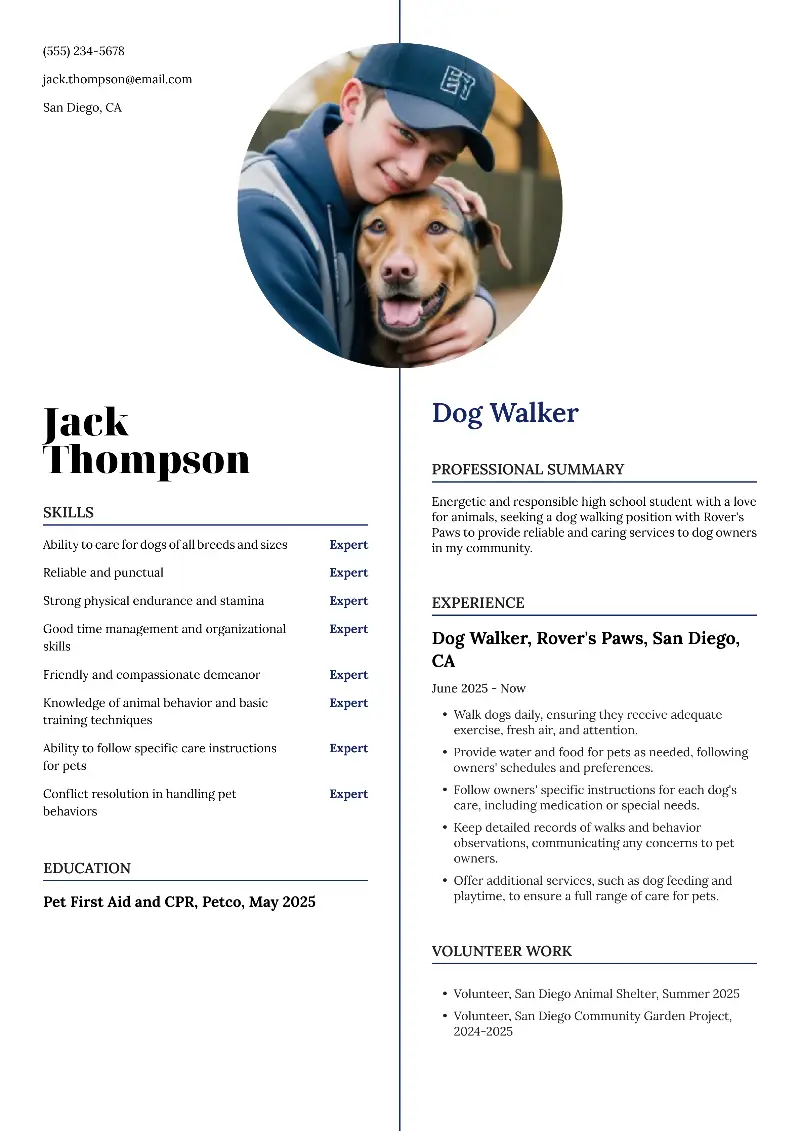A great resume is more than just a list of qualifications and achievements—it’s a reflection of your personal brand.
Among the many elements that can set you apart from other candidates, interpersonal skills are becoming increasingly crucial. Employers are looking not only for technical expertise but also for candidates who can effectively communicate, collaborate, and build relationships within a team.
In this article, we’ll explore how to highlight your people skills on a resume, providing you with practical tips and examples to showcase your ability to navigate the social dynamics of the workplace.
What are interpersonal skills for a resume?
Interpersonal skills, often referred to as "people" or "soft", are the abilities that enable you to interact harmoniously with others.
These capacities encompass a range of qualities and competencies that are crucial for successful communication, collaboration, and relationship-building in both personal and professional settings.
Types of interpersonal skills
People skills for resumes are diverse and can be categorized into several types, each contributing to effective interactions.
Resume interpersonal skills types:
- Communication Skills
- Active Listening
- Empathy
- Conflict Resolution
- Teamwork and Collaboration
- Emotional Intelligence
- Leadership
- Networking
- Adaptability
- Persuasion and Influence
- Problem Solving
- Patience and Tolerance
- Cultural Sensitivity
How to put interpersonal skills on a resume?
Effectively showcasing your soft skills involves more than just listing them; it requires demonstrating how these abilities have positively impacted your work and achievements.
Below is how you can strategically underline people skills on your resume.
Step 1. Identify relevant attributes
Start by identifying which interpersonal skills are most pertinent to the occupation you're applying for. Review the job description carefully to pinpoint abilities that align with the role.
Step 2. Use specific examples
Instead of merely listing your valuable skills, provide concrete examples of how you've applied these capacities in previous roles. This approach not only highlights your capabilities but also demonstrates your effectiveness in real-world scenarios.
Whenever possible, apply numbers to illustrate the impact of your interpersonal attributes.
Step 3. Incorporate in sections
Your headline is an excellent place to briefly mention your key interpersonal traits. This block should be a concise snapshot of your career and how your abilities have contributed to your success.
Example:
Results-driven marketing specialist with over 7 years of experience in leading cross-functional teams. Adept at fostering collaboration, resolving conflicts, and communicating effectively to drive strategic initiatives and achieve company goals.
Skills Section
Create a dedicated block where you list your strong interpersonal skills in bullet points. Be specific and use language that reflects your experience and proficiency.
Professional Experience
In the work history, weave your people skills into the descriptions of your past roles. Focus on how these interpersonal strengths contributed to your achievements in each position. Utilize action verbs and quantify results to add impact.
Example:
Project Manager, Scolopoint
New York, NY
May 2022 - June 2024
- Led a cross-functional team of 12 in the launch of a major software update, improving team productivity by 25%.
- Employed active listening and empathy to resolve interpersonal conflicts, resulting in a 40% reduction in project delays due to team disagreements.
Achievements
Highlight any specific accomplishments that demonstrate your interpersonal abilities. These could be awards, recognitions, or successful projects where your skills were pivotal.
Example:
Awarded "Team Player of the Year" for exceptional leadership and collaboration during a high-stakes project, which led to a 15% increase in client satisfaction.
Additional Sections
Place interpersonal skills into other resume parts such as volunteer work, professional affiliations, or certifications to further showcase your abilities.
Step 4. Use Keywords
Incorporate keywords related to people skills from the job description to ensure your resume aligns with the employer's expectations. This can also help your application pass through Applicant Tracking Systems (ATS) that screen for specific terms.
Step 5. Keep It Concise
While it’s important to provide a detailed overview, be mindful of resume length and readability. Focus on the most impactful examples of your interpersonal skills, ensuring that each bullet point adds value and supports your candidacy.
This is how a resume with interpersonal skills may look like:
Create your professional Resume in 10 minutes for FREE
Build My Resume
List of interpersonal skills for resume
To help you present your strengths effectively on your resume, we’ve outlined a comprehensive top of interpersonal skills examples divided into key categories.
Communication skills:
- Public Speaking: Delivering presentations and speeches effectively to diverse audiences.
- Active Engagement: Participating in conversations with focus and interest.
- Clarity: Expressing thoughts in a clear and straightforward manner.
- Storytelling: Using narratives to make complex ideas relatable and memorable.
- Feedback Delivery: Providing constructive criticism in a positive and actionable manner.
- Instruction: Guiding others through processes or tasks with precision and clarity.
- Persuasive Communication: Convincing people through logical arguments and compelling evidence.
- Interpersonal Communication: Building relationships through effective dialogue and interaction.
- Cross-Cultural Communication: Navigating and respecting cultural differences in communication styles.
- Conflict Communication: Addressing disagreements or issues directly and tactfully.
- Digital Communication: Effectively conveying messages through emails, chats, and social platforms.
Active listening
- Attention to Detail: Noticing subtle cues and nuances in the speaker’s message.
- Paraphrasing: Repeating what has been said in your own words to ensure understanding.
- Summarizing: Condensing key points from a conversation to clarify and validate comprehension.
- Encouraging Responses: Utilizing verbal and non-verbal cues to prompt further discussion.
- Empathic Responses: Reflecting back on the emotions expressed by the talker.
- Avoiding Interruptions: Allowing the spokesman to complete their thoughts without interjecting.
- Non-Verbal Feedback: Using body language, such as nodding or eye contact, to show attentiveness.
- Clarifying Questions: Asking questions to resolve uncertainties and gain a deeper understanding.
- Retaining Information: Remembering details from conversations for future reference.
- Listening for Understanding: Focusing on the presenter's point rather than formulating your response.
- Open-Mindedness: Receiving information without immediate judgment or bias.
Empathy:
- Emotional Validation: Acknowledging and affirming others’ experiences.
- Understanding Perspectives: Seeing situations from others’ viewpoints to foster mutual respect.
- Compassionate Listening: Providing a supportive ear to those in distress.
- Supportive Feedback: Offering encouragement and understanding to help others cope.
- Non-Judgmental Attitude: Accepting others’ feelings without passing judgment or criticism.
- Emotional Resonance: Connecting with the emotional content of conversations.
- Sensitive Communication: Choosing words and actions that are considerate of others’ feelings.
- Encouraging Openness: Creating a safe space for others to express their emotions.
- Recognizing Non-Verbal Cues: Noting body language and other non-verbal signs of emotional states.
- Responding with Care: Tailoring your responses to meet the emotional needs of others.
- Building Trust: Demonstrating reliability and understanding to strengthen relationships.
Conflict resolution
- Problem Identification: Determining the underlying issues causing conflicts.
- Solution Generation: Developing multiple options for resolving disagreements.
- Mediation: Acting as a neutral party to facilitate discussions between conflicting sides.
- Negotiation: Finding common ground through compromise and agreement.
- Emotional Management: Keeping emotions in check during conflict situations to remain objective.
- Assertiveness: Communicating your own needs and boundaries respectfully.
- Consensus Building: Encouraging all parties to agree on a mutually acceptable solution.
- Diplomacy: Handling sensitive issues with tact and respect.
- Follow-Up: Checking in after resolution to ensure all parties are satisfied and issues are resolved.
- De-Escalation: Reducing the intensity of conflicts through calm and measured responses.
- Active Listening: Truly hearing each side to understand concerns fully.
Teamwork and collaboration:
- Joint Problem Solving: Working with others to solve issues collectively.
- Role Assignment: Clearly defining and delegating tasks according to team members' strengths.
- Coordinated Efforts: Aligning individual contributions to achieve team goals efficiently.
- Building Trust: Establishing and maintaining confidence among team members.
- Motivating Peers: Encouraging and inspiring team members to perform at their best.
- Sharing Knowledge: Contributing expertise and information to benefit the team.
- Facilitating Meetings: Leading discussions and ensuring productive participation from all team members.
- Conflict Management: Addressing and resolving issues within the team to maintain harmony.
- Adaptability: Adjusting your approach based on team dynamics and feedback.
- Recognizing Achievements: Celebrating team successes and acknowledging individual contributions.
- Supporting Diversity: Valuing different perspectives and backgrounds to enhance creativity.
Emotional intelligence
- Self-Awareness: Recognize your own emotions and their effect on your behavior.
- Self-Regulation: Controlling your emotional responses and maintaining composure.
- Empathy: Understanding and responding to the emotions of others.
- Social Skills: Building positive relationships through effective interactions.
- Motivation: Using emotional awareness to drive personal and professional goals.
- Stress Management: Handling stress in a way that minimizes its impact on your performance and well-being.
- Relationship Management: Navigating and managing interactions with others to foster productive relationships.
- Emotional Awareness: Being attuned to the emotional climate of your environment and replying appropriately.
- Impulse Control: Resisting urges that may lead to negative consequences.
Leadership:
- Vision Setting: Defining and articulating a clear and compelling direction for the team or project.
- Inspiration: Motivating and encouraging team members to strive towards goals.
- Decision Making: Supporting informed and timely decisions that benefit the organization.
- Delegation: Assigning tasks and responsibilities effectively, leveraging team members' strengths.
- Goal Setting: Establishing clear, achievable objectives and guiding the team toward them.
- Mentorship: Providing guidance and support to help team members grow and develop professionally.
- Feedback: Offering constructive criticism and praise to improve performance and morale.
- Strategic Planning: Developing long-term plans and strategies to achieve organizational goals.
- Change Management: Leading and supporting the team through organizational changes and transitions.
- Empowering Others: Encouraging autonomy and decision-making to build confidence and skills.
Networking
- Relationship Development: Building and nurturing professional relationships for mutual benefit.
- Effective Introductions: Connecting with new contacts in a way that establishes rapport and credibility.
- Maintaining Connections: Keeping in touch with professional contacts through follow-ups and regular communication.
- Leveraging Contacts: Utilizing your network to gain insights, possibilities, or support.
- Professional Visibility: Increasing your presence and influence within your industry or professional community.
- Event Participation: Engaging in industry events and opportunities to expand your network.
- Value Exchange: Offering help or resources to others in your network, fostering reciprocal support.
- Cross-Industry Networking: Engaging with professionals from different fields to gain diverse perspectives.
- Networking Strategy: Developing a structured approach to building and managing your professional network.
- Effective Follow-Up: Reaching out to new contacts after initial meetings to reinforce relationships and explore collaboration.
- Personal Branding: Showcasing your unique skills and expertise to attract relevant contacts.
Adaptability:
- Flexibility: Adjusting your methods and strategies in response to changing circumstances.
- Problem-Solving: Developing innovative solutions when faced with unexpected challenges.
- Learning Agility: Rapidly acquiring new skills and knowledge to adapt to evolving needs.
- Open-Mindedness: Embracing new ideas and approaches with a willingness to change.
- Resilience: Bouncing back from setbacks and maintaining a positive attitude.
- Quick Thinking: Making effective decisions under pressure or in rapidly shifting situations.
- Prioritization: Adjusting priorities and focus based on emerging demands or shifts in goals.
- Versatility: Performing various roles and tasks as needed to support team objectives.
- Acceptance of Feedback: Welcoming and incorporating constructive criticism to improve performance.
- Proactive Adjustment: Anticipating potential changes and preparing to address them effectively.
- Resourcefulness: Identifying and utilizing available tools and support to manage new challenges.
Persuasion and influence
- Logical Argumentation: Presenting reasoned arguments and evidence to persuade others.
- Emotional Appeal: Connecting with others on an emotional level to gain support or agreement.
- Negotiation: Reaching agreements through dialogue and compromise that align with your objectives.
- Influential Communication: Using persuasive language and techniques to affect others’ opinions or behaviors.
- Building Rapport: Establishing trust and understanding to enhance your influence.
- Credibility: Demonstrating expertise and reliability to strengthen your efforts.
- Strategic Persuasion: Tailoring your approach based on the audience and context to maximize impact.
- Handling Objections: Addressing concerns and resistance effectively to move conversations forward.
- Motivational Speaking: Inspiring and energizing others through compelling and impactful messages.
- Collaborative Influence: Utilizing teamwork and collaboration to influence outcomes and achieve shared goals.
- Social Proof: Leveraging endorsements, testimonials, or group consensus to reinforce your position.
Cultural competence:
- Language Sensitivity: Being mindful of differences, avoiding jargon or idiomatic expressions that may be unclear.
- Non-Verbal Cues: Being aware that body language, facial expressions, gestures, and eye contact may carry different meanings across cultures.
- Avoiding Stereotyping: Challenging assumptions by focusing on individuals' unique qualities and contributions.
- Celebrating Diversity: Actively participating in or organizing events that highlight the importance of cultural difference.
- Flexibility: Adapting your work style to align with the expectations of team members from various regions or backgrounds.
- Global Perspective: Viewing issues from a broader, international perspective and understanding how trends, regulations, and cultural norms may impact decision-making.
- Collaborating Across Time Zones: Coordinating and working effectively with teams from various places.
- Championing Inclusion: Actively promoting a culture of inclusivity within the workplace by encouraging diverse voices, fostering open discussions, and advocating for policies.
- Inclusive Decision Making: Ensuring that decisions, meetings, and projects take into account the perspectives and input of individuals from diverse backgrounds.
- Reducing Discrimination: Helping to identify and eliminate bias or unfair treatment in the workplace.
Conclusion
Preparing a resume that showcases your strengths in areas such as leadership, adaptability, and emotional intelligence not only enhances your professional profile but also raises you above the rest of the applicants.
As you write your application, focus on illustrating how your interpersonal skills have driven success in your previous roles and how they align with the needs of prospective employers.
Create your professional Resume in 10 minutes for FREE
Build My Resume


































